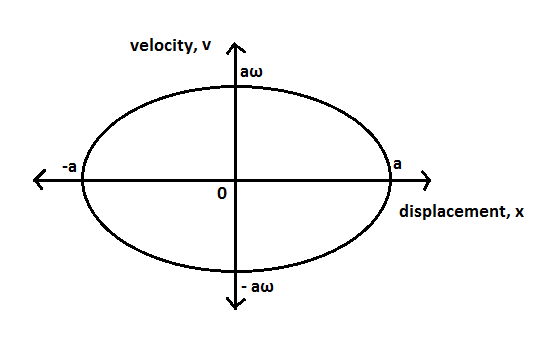Question
Question: Statement 1: The graph between velocity and displacement for a harmonic oscillator is an ellipse. ...
Statement 1: The graph between velocity and displacement for a harmonic oscillator is an ellipse.
Statement 2: Velocity does not change uniformly with displacement in harmonic motion.
A) Statement 1 is false, statement 2 is true
B) Statement 1 is true, statement 2 is true, Statement 2 is the correct explanation for statement 1
C) Statement 1 is true, statement 2 is true, Statement 2 is not the correct explanation for statement 1
D) Statement 1 is false, statement 2 is false.
Solution
Velocity of a particle in a simple harmonic motion can be given in terms of amplitude, angular velocity and position of the particle. Squaring and dividing the equation accordingly, we can convert the equation into the equation for ellipse.
Formula used:
v=ωa2−x2
Complete step-by-step solution:
In a simple harmonic motion, velocity is given by,
v=ωa2−x2
Where,
ωis the angular frequency
x is the position of the particle.
ais the amplitude of the particle
Then,
v2=ω2a2−ω2x2 --------- 1
Dividing both sides of the equation 1 by ω2a2
ω2a2v2=1−ω2a2ω2x2
ω2a2v2+a2x2=1 ---------- 2

Velocity-displacement graph of a harmonic oscillator.
We have equation for ellipse as,
a2x2+b2y2=1 ------------- 3
Comparing equations 2 and 3, we can say that the graph between velocity and displacement for a harmonic oscillator is an ellipse.
From the elliptical graph we can understand that the velocity is not changing uniformly with displacement in harmonic motion.
Hence, statement 1 is true, statement 2 is true, Statement 2 is not the correct explanation for statement 1.
Hence the answer is option C.
Note: The position of a particle in a simple harmonic motion is given by,
x=Asinωt
Where,
A is the amplitude
ω is the angular frequency
t is the time
Then,
sinωt=Ax
Squaring the equation on both sides,
sin2ωt=A2x2
Velocity in a simple harmonic motion is given by,
v=Aωcosωt
Then,
cosωt=Aωv
Squaring the equation on both sides,
cos2ωt=A2ω2v2
sin2ωt+cos2ωt=a2x2+A2ω2v2
We have,
sin2x+cos2x=1
Then,
a2x2+A2ω2v2=1 ---------- (1)
Equation for ellipse is given by, a2x2+b2y2=1 ----------(2)
Comparing the equations 1 and 2 we can see that the graph between velocity and displacement for a harmonic oscillator is an ellipse.
